by Lisa Cooke | Jun 11, 2015
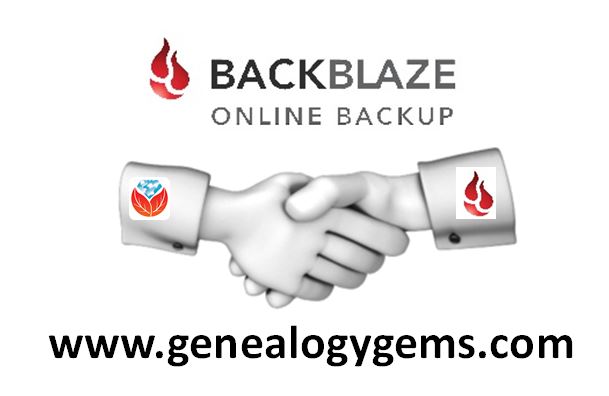 In the last year I’ve moved from Earthquake Central (California) to Tornado Alley (Texas) and it’s been a bit of an adjustment, to say the least! Recently I presented a live webinar on using Evernote for genealogy during a tornado watch, with my husband fretting in the background. Not long after, we spent an hour in our shelter room during torrential rains, non-stop lightning, and nearby tornado touchdowns.
In the last year I’ve moved from Earthquake Central (California) to Tornado Alley (Texas) and it’s been a bit of an adjustment, to say the least! Recently I presented a live webinar on using Evernote for genealogy during a tornado watch, with my husband fretting in the background. Not long after, we spent an hour in our shelter room during torrential rains, non-stop lightning, and nearby tornado touchdowns.
All this threat of danger and destruction has reinforced my decision to bring into our Genealogy Gems family a brand new sponsor. Backblaze is now the official back up of Lisa Louise Cooke’s Genealogy Gems. Backblaze isn’t new to the genealogy space: if you’ve been to RootsTech, you’ve likely seen their booth. Backblaze is a trusted online cloud backup service that truly makes backing up all your most precious computer files super easy.
Many of you have asked me which company I use to back up my files. I’ve done my homework and Backblaze is my choice. The thought of losing my genealogy files is too much to bear. Now I can concentrate on keeping my loved ones safe through the storms of life because I know Backblaze is taking care of my files and photos! A few things to consider:
- They back up ALL your files (or just those you select). Music, photos, data, documents, etc.
- You have an unlimited amount of data storage on Backblaze.
- In the event you lose data, you can download from any computer or have a hard drive FedExed to you.
- For the price of a single average hard drive restoration (when it’s even possible), Backblaze could back up your computer for 50 years.
- External drives are great, but if they’re sitting next to your computer, they would be lost in a natural disaster, too.
- Backblaze serves both Mac and PC owners.
- You can get started for free. And then it’s really inexpensive to have them continuously back you up. Only $5 per month, last we checked, or $50 for an entire year.
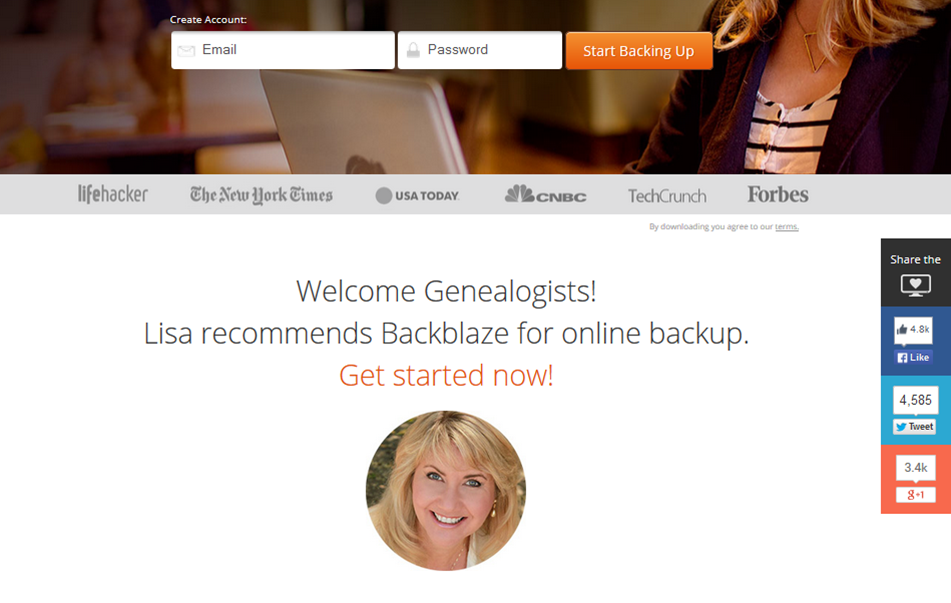 I invite you to visit www.Backblaze.com/Lisa and get all your files backed up once and for all!
I invite you to visit www.Backblaze.com/Lisa and get all your files backed up once and for all!
by Lisa Cooke | Dec 17, 2013 | 01 What's New, Video
According to Jan Langer, there are said to be over 700 people over the age of 100 living int he Czech republic. Langer “wondered what changes and what remains on a human face and in a human mind in such a long time, and in such a short while in relative terms. I wondered how much loneliness of the old age weighs, and what memories stay in 100-year-old mind.”
In this riveting time lapse video, Langer explores the similarities and the differences in appearance and in physiognomy over 100 years. He used comparative photos (archive portraits from family albums and contemporary portraits) to bring the faces through time. Personally I find the old faces as captivating as the young.
Though characteristics of personality change over time, Langer says it “seems as if individual nature remains rooted in the abyss of time.”
The series was created as a part of a project for Aktualne.cz.
More information can be found at www.fotojatka.cz
Like this? Please share it using our social media buttons.
by Lisa Cooke | Feb 13, 2017 | 01 What's New, DNA |
The genetic genealogy community has a crush. A big one. Everyone is talking about it. “It has such great features,” says one. “It has a chromosome browser!” exclaims another. “It’s FREE!” they all shout. What’s all the hype about? GEDmatch.
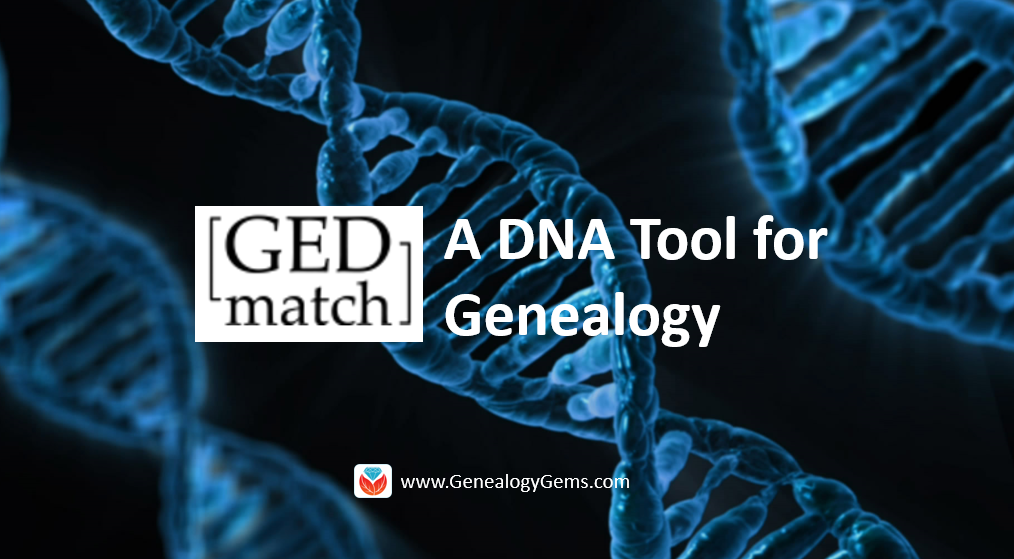
GEDmatch is a mostly free online tool where anyone with autosomal DNA test results from 23andMe, FTDNA, and AncestryDNA can meet and share information. All you need to do is download your data from your testing company and upload it into your newly created GEDmatch account.
GEDmatch Set-up
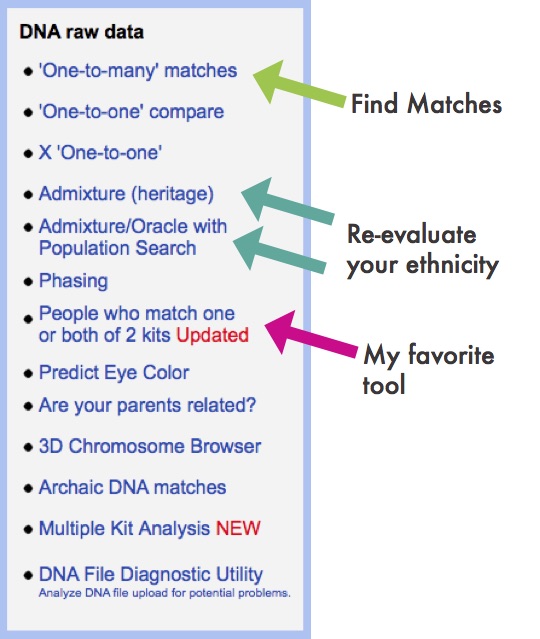
Gedmatch Find Matches
GEDmatch is set up just like your testing company and provides two kinds of reports: ethnicity results and a match list. Remember, ethnicity results, meaning those pie charts that report you are 15% Italian and 32% Irish, are based on two factors: a reference population and fancy math. GEDmatch has gathered data from multiple academic sources to provide you with several different iterations of ethnicity reports. This is like getting a second (and third and fourth, etc) opinion on a science that is still emerging. It is a fun exercise, but will likely not impact your genealogy research very much.
The more important match list does allow you to see genetic cousins who have tested at other companies. Of course, only those who have downloaded their results and entered them into GEDmatch will show up on your list. This means GEDmatch has the potential to expand your pool of genetic cousins, increasing your chances of finding someone to help you track down that missing ancestor.
Many also flock to GEDmatch because they were tested at AncestryDNA and so do not have access to a chromosome browser. A chromosome browser allows you to visualize the physical locations that you share with someone else (see below). Some find this a helpful tool when analyzing their DNA matches, though in my opinion, it is not essential.

Example
GEDmatch also has some great genealogy features that let you analyze your pedigree against someone else’s, as well as the ability to search all the pedigree charts in their system so you can look specifically for a descendant of a particular relative. However, even with all of these great features, GEDmatch is still yet another website you have to navigate. With that, there will be a learning curve and certainly some frustration.
GEDMatch or Not?
So, is it worth it? If you are fairly comfortable with the website where you were tested, and you are feeling both curious and patient, I say go for it!
It’s too much to tell you right this minute how to download your data from your testing site and upload it to GEDmatch, but you’re in luck! I’ve put step-by-step instructions for getting started in a free tutorial on my website at www.yourDNAguide.com/transferring.
by Lisa Cooke | Jan 11, 2015 | 01 What's New, British, Newspaper, Research Skills
The British Newspaper Archive celebrated its 3rd birthday recently by looking back at how people are searching its 9 million+ newspaper pages. To date, the five  most common searches are:
most common searches are:
1. Football
2. Murder
3. Death
4. Jack the Ripper
5. Railway
Not what you expected? Your digitized newspaper searches as a family historian may be a little more specific and less sports-and-murder oriented. But are they too general to yield successful results?
Here’s a tip from Lisa: “With 9 million searchable pages, the key to finding what you want is to use the Advanced Search.
 “You’ll find it under the search box. My initial search for my husband’s great grandfather resulted in tens of thousands of hits until I included mandatory keywords, his name as a phrase, a defined time frame, and zeroed in on advertisements. The 299 results were far more manageable and resulted in several fantastic finds!”
“You’ll find it under the search box. My initial search for my husband’s great grandfather resulted in tens of thousands of hits until I included mandatory keywords, his name as a phrase, a defined time frame, and zeroed in on advertisements. The 299 results were far more manageable and resulted in several fantastic finds!”
Armed with these tips, those with Irish or English roots should explore The British Newspaper Archive, even if you’ve searched there before. “We’ve come a long way since the website launched on 29 November 2011 with 4 million historic newspaper pages,” says a press release. “The collection is now more than twice the size, with over 9 million fully searchable pages available from 300 British and Irish titles. The newspapers cover 1710 – 1954, a much broader time period than at launch. If you weren’t able to find a particular person, event or place when The British Newspaper Archive launched, it’s well worth looking again now.” Visit www.britishnewspaperarchive.co.uk to try a search for free.”
Learn more about searching historical newspapers in Lisa’s book, How to Find Your Family History in Newspapers. Chapter 4 is all about the newspaper search process, and includes a copy-able Newspaper Research Worksheet.
Last of all, check out this fun infographic below from the British Newspaper Archive in honor of its birthday:
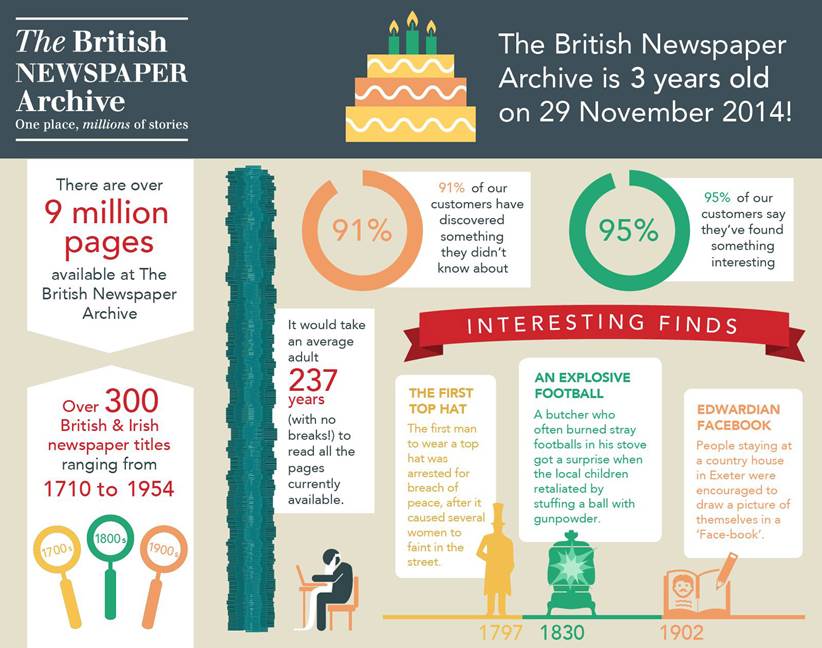
 In the last year I’ve moved from Earthquake Central (California) to Tornado Alley (Texas) and it’s been a bit of an adjustment, to say the least! Recently I presented a live webinar on using Evernote for genealogy during a tornado watch, with my husband fretting in the background. Not long after, we spent an hour in our shelter room during torrential rains, non-stop lightning, and nearby tornado touchdowns.
In the last year I’ve moved from Earthquake Central (California) to Tornado Alley (Texas) and it’s been a bit of an adjustment, to say the least! Recently I presented a live webinar on using Evernote for genealogy during a tornado watch, with my husband fretting in the background. Not long after, we spent an hour in our shelter room during torrential rains, non-stop lightning, and nearby tornado touchdowns. I invite you to visit www.Backblaze.com/Lisa and get all your files backed up once and for all!
I invite you to visit www.Backblaze.com/Lisa and get all your files backed up once and for all!



 most common searches are:
most common searches are: “You’ll find it under the search box. My initial search for my husband’s great grandfather resulted in tens of thousands of hits until I included mandatory keywords, his name as a phrase, a defined time frame, and zeroed in on advertisements. The 299 results were far more manageable and resulted in several fantastic finds!”
“You’ll find it under the search box. My initial search for my husband’s great grandfather resulted in tens of thousands of hits until I included mandatory keywords, his name as a phrase, a defined time frame, and zeroed in on advertisements. The 299 results were far more manageable and resulted in several fantastic finds!”